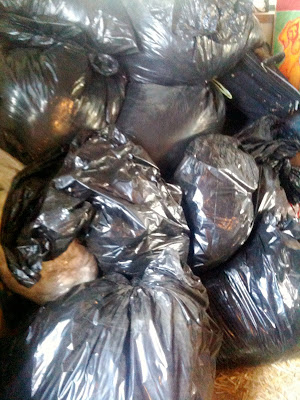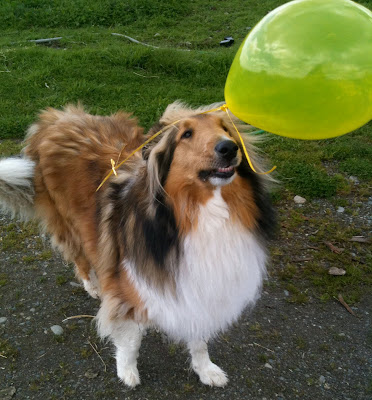Farmsitter Instructions:
These are divided into two parts: Farm, and house. Farm first.
There is one rule which is far and away the most important of all - if you do nothing else, please do this! Keep the door to the milking barn closed and locked at all times. The latch must be shot and turned down; if not turned down, Iris can open it. If the goats get into the milking barn, they will eat grain until they blow up and die. The grain canisters have lids, and please keep the lids on, but I think the goats would knock the whole bin over and work like crazy until they could get at the grain. Then they would die. So that’s rule number one, the alpha and the omega of farmsitting.
Okay. Now I know the hardest task, far and away, will be milking, so I’m going to go into detail here. I know you will have had some hands-on practice, but just in case. When you open the door to the milking barn, all the does will try to crowd in. Bodyblock all but one. Whichever doe it is will run in and jump up on the milking stand. Push her head down into the stanchion and lock it. Now she’s trapped!
There is a canister of clorox wipes on the shelf. They are there to clean off the teats before milking, but I only use them if it’s been raining and the udder is obviously muddy or gross. Use your own judgement. I do direct the first couple of squirts of milk into the hay on the floor - this clears out any bacteria that may have built up in the teat since the last milking. Third squirt goes in the jar.
The name of the game when milking is to extract maximum milk for minimum grain. The does really should not get more than one scoop of grain per milking (the scoop will be in the bin). However, you will soon notice that as long as they have food they are easy to milk, but when they run out they immediately start to kick and complain. Dole out the grain by small handfuls, but even so, they will run out of grain before you run out of milk. Three suggestions: wear old clothes to milk, because you WILL get the milk jar spilled on you at least a few times. It happens to me, and I’ve been milking twice a day for three years now. Number two: when they start to kick, slap them on the hindquarters (hard) and yell “no!” They all know what this means. It will buy you a few minutes. Lastly, if you need it, there is a bungi cord and some hooks to wrap up the hind legs with. Usually I get done without this, but I am well practiced. My guess is you will need to use the cord on Iris.
A few notes about Iris. By the time this stint is over, you will either love Iris or hate her. Maybe both. There are good things about Iris - she’s a beautiful goat. She’s healthy and smart, and she is a milk-making-machine. All of these excellent qualities have their downside. She is so smart she is tricky. She is the only goat who can open the barn door. When you are milking another goat, remember to shoot the inside latch, or Iris will open the door and jump in before you can stop her. She makes so much milk (about three quarts per milking) that it takes for freakin’ ever to milk her. Also she knows perfectly well about the grain/milk ratio game and she eats like a speed demon. She kicks like a mule. I often find myself cursing like a sailor while milk runs down my legs as Iris looks at me sidewise and laughs. Be firm and remember, you are smarter than the smartest goat. Probably.
It is important to try to “strip” the teat to get all the milk out. There is no such thing as a totally empty udder, so don’t go on forever, but when the flow visibly diminishes and the teat starts to look shriveled, wait a minute or two and then milk some more. Several more healthy squirts will come out. The second time the flow diminishes, she’s done. Leaving too much milk in the udder invites mastitis, which is what we want to avoid.
Getting the goats INTO the barn is the easy part. Getting them OUT after they have been milked is harder. Remember, as you try to get a goat out, the other goats will be trying to get in. Do NOT open the door before you have opened the stanchion and maneuvered the goat to the door. I sling my arm around the goat’s neck and catch them with the crook of my elbow and guide them off the stand and over to the door. Then I open the door and push the goat out (and I do mean PUSH) while blocking the other goats from jumping in. This works pretty well, but if you have trouble, I keep a stout switch up against the wall. Grab and lay about you with vigor. Don’t be shy; beat the HECK out of those goats if necessary. You aren’t going to hurt them.
You can expect about a gallon and a quart at each milking. Most of that will be from Iris. I don’t care what you do with the milk - by all means - drink it, share it with friends and family, whatever you like. But if it gets too much, you can also feed it to the dogs or the chickens. I won’t be offended! If you want to drink it, you should bring it in and filter it through a coffee filter and refrigerate it as quickly as possible. I’ve gotten pretty good at avoiding this, but as a novice, you should expect some hairs and flecks in the milk. That’s what the coffee filter is for. Of course, if a goat succeeds in putting her whole foot in the bucket (as they sometimes do) that milk should be discarded.
Okay that’s all I can think of for milking. Feeding is pretty self-explanatory. The horses are on pasture, they need nothing. The goats should have hay in the feeder, but the feeder holds a whole bale and so doesn’t need to be replenished more often than once a week. In between,. just lift the lid and fluff it up so they can reach. The scoop for chicken food is in the chicken food bin - I just open the window of the barn and scatter it out on the ground. The goats and horses will come eat, but don’t sweat it. The chickens will get plenty.
Oh speaking of chickens, there is a broody hen in the coop. She’s one of the speckled hens. Just leave her alone and don’t try to gather her eggs. It would be nice if you could remember to scatter some grain inside the coop for her and use the hose to fill the waterer, but she’ll be okay either way. The hens like to lay in the hayloft and also in the hay feeder. You can expect six to ten eggs a day. Again - do what you like with them.
Water - just try to keep the buckets full. Morning and night is enough. If it is really hot and sunny, I guess algae might build up in the buckets. If so, dump them and squirt the high-pressure hose on them before filling them again. Pretty simple.
Um. It’s getting pretty late and I’m running out of thoughts. You know where the dog and cat food is. Feed the cat where the dogs can’t get it - I feed him up on the table in the playroom. Try REALLY hard not to let Lancelot (the collie) out. He goes over to the neighbor’s house and causes all kinds of trouble. In fact, the dogs don’t need to go out at all, really. They have the backyard and the playroom. Just leave the door to the backyard open so they can go out to poop. They can sleep outside or inside, doesn’t matter. If Ivory sleeps inside she will wake you up about seven A.M. to let her out to pee, so you might want to just have her sleep outside.
I have set up an account with the vet (number on the fridge) so if there is an emergency you can get the animals treatment. The goats can be transported in the van and I’ll leave you the keys just in case. Be aware, however, that I have been battling with worms and coccidia all spring. Simple diarrhea is not cause for the vet. It’s just par for the course at the moment. I have just wormed the goats and right now everyone is healthy. Hope they stay that way. I think I’ve covered everything. I’ll check again in the morning. Also, in the morning I’ll write out the house instructions.

























